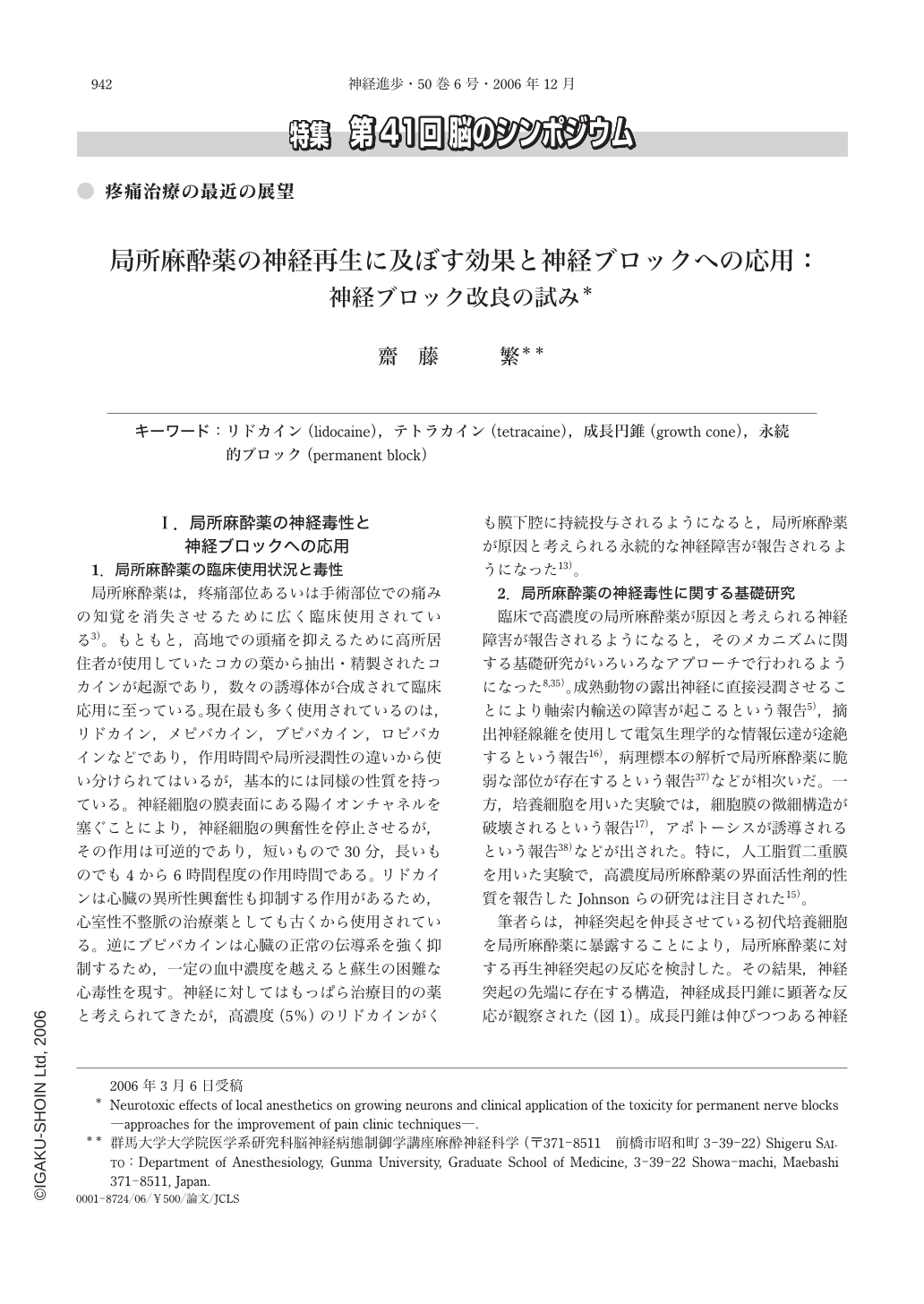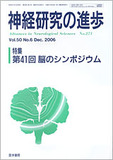Japanese
English
- 有料閲覧
- Abstract 文献概要
- 1ページ目 Look Inside
- 参考文献 Reference
Ⅰ.局所麻酔薬の神経毒性と神経ブロックへの応用
1.局所麻酔薬の臨床使用状況と毒性
局所麻酔薬は,疼痛部位あるいは手術部位での痛みの知覚を消失させるために広く臨床使用されている3)。もともと,高地での頭痛を抑えるために高所居住者が使用していたコカの葉から抽出・精製されたコカインが起源であり,数々の誘導体が合成されて臨床応用に至っている。現在最も多く使用されているのは,リドカイン,メピバカイン,ブピバカイン,ロピバカインなどであり,作用時間や局所浸潤性の違いから使い分けられてはいるが,基本的には同様の性質を持っている。神経細胞の膜表面にある陽イオンチャネルを塞ぐことにより,神経細胞の興奮性を停止させるが,その作用は可逆的であり,短いもので30分,長いものでも4から6時間程度の作用時間である。リドカインは心臓の異所性興奮性も抑制する作用があるため,心室性不整脈の治療薬としても古くから使用されている。逆にブピバカインは心臓の正常の伝導系を強く抑制するため,一定の血中濃度を越えると蘇生の困難な心毒性を現す。神経に対してはもっぱら治療目的の薬と考えられてきたが,高濃度(5%)のリドカインがくも膜下腔に持続投与されるようになると,局所麻酔薬が原因と考えられる永続的な神経障害が報告されるようになった13)。
Local anesthetics are widely used for topical or regional anesthesia. The effects are generally reversible and interrupt pain sensation for a limited duration. However, neurotoxicity of local anesthetics has been reported both in clinical and experimental studies. Several in vivo and in vitro studies have demonstrated that tetracaine and lidocaine directly injured matured neuronal tissues.
Neurotoxic effects of local anesthetics are not only observed in matured neurons, but also in growing or regenerating neurons. Growth cone is the highly motile structure at the end of the growing axons and dendrites, and has a crucial role in path finding and cytoarchitecture establishment in developing nervous system. Substances, which induce abnormal collapse of growth cones, possibly provoke some teratogenicity when used for embryos or neonates, or abnormal regeneration when applied to injured nervous tissues.
In our previous studies, we demonstrated that local anesthetics induced growth cone collapse both concentration and exposure time dependently. Although clinically applied local anesthetics are quickly diluted by cerebrospinal or interstitial fluid, the concentrations tested in our studies were lower than clinically prepared solutions and may be within the range encountered in clinical settings, such as local infiltration around injured tissues. Local anesthetics induce collapse and Ca2+ increase at growth cones simultaneously, however, these two phenomena might be provoked independently. Because, local anesthetics induced growth cone collapse even in the Ca2+ free culture media and intracellular Ca2+ chelator could not inhibit the growth cone collapse.
We applied the neurotoxic effects for semi-permanent trigeminal nerve block. Although the analgesic effects of infraorbital nerve block using 0.5% bupivacaine or 1% mepivacaine dissipated within a few days, the effects of nerve blocks using 4% tetracaine continued for more than 3 months. Compared to classical permanent nerve blocks with phenol or ethanol, nerve blocks with a high-concentration local anesthetic are safer and free from serious complications.
In addition to clinical introduction of nerve blocks with high concentration local anesthetics, several other approaches have been adopted to improve pain clinic techniques. Routine use of CT fluoroscopy during nerve block needle placement is another example. Gasserian ganglion block is an established treatment for trigeminal neuralgia. A landmark approach assisted by X-ray fluoroscopy is the most common method;however, visualization of the foramen ovale is difficult in some cases. Then, we devised a novel technique using modern computed tomography(CT)fluoroscopy. Thermal coagulation at 90 degrees C following electrical stimulation makes the technique safer and more reliable. Satisfactory analgesia was obtained in most of the cases without any complications. The same technique can be used for percutaneous radiofrequency facet rhizotomy to treat chronic low back pain.
Direct visualization of nerves with endoscopy is the other efforts to improve the nerve block techniques. Thoracic endoscopic sympathectomy under one lung ventilation is an example that has already been applied clinically. Epiduroscope and contact scope are also promising tools to visualize nerve roots. Many trials will be conducted to make pain clinic techniques more sophisticated ones. More than destruction of nerve tissues, promotion of nerve regeneration with trophic factors or introduction of new drug delivery systems are going to be combined with nerve block techniques. We confirmed that several neurotrophic factors, such as brain derived neurotrophic factor, neurotrophin-3 and glia derived neurotrophic factor, are effective to support the regeneration of neurons that had been injured by high concentration local anesthetics.

Copyright © 2006, Igaku-Shoin Ltd. All rights reserved.


